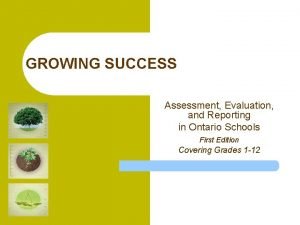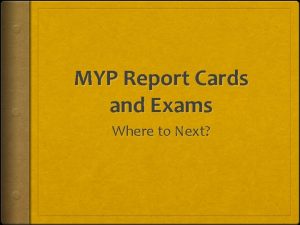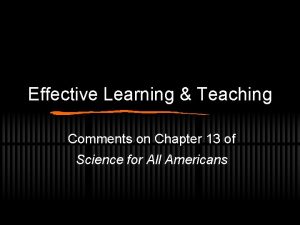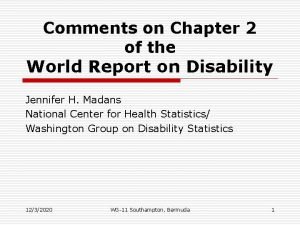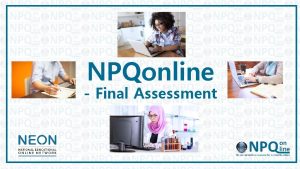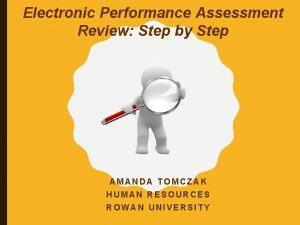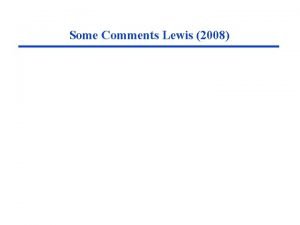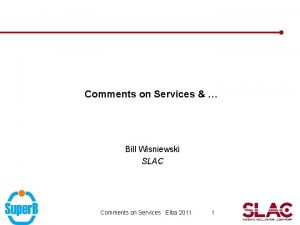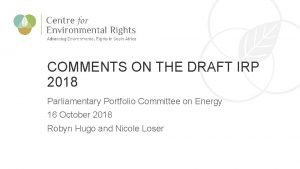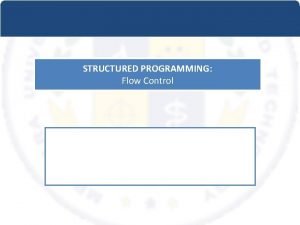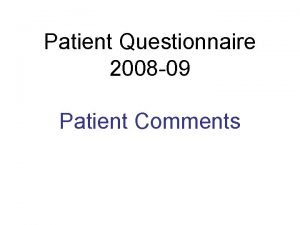Comments on Chapter 2 of the World Report

















- Slides: 17

Comments on Chapter 2 of the World Report on Disability Jennifer H. Madans National Center for Health Statistics/ Washington Group on Disability Statistics 12/3/2020 WG-11 Southampton, Bermuda 1

WR Recommendations: To enhance the availability and quality of data on disability the WR recommends: • Adoption of the ICF • Improved national disability statistics • Improved comparability of data • Development of appropriate tools (both quantitative and qualitative methodologies) to improve and expand data collection on disability. 12/3/2020 WG-11 Southampton, Bermuda 2

WR Recommendations: • Collection of national population census data according to the recommendations from the Washington Group on Disability Statistics (WG) and the UN Statistical Commission • Development and testing of extended measures of disability for use in population surveys or as the core of a disability survey as initiated by the WG/Budapest Initiative (BI). 12/3/2020 WG-11 Southampton, Bermuda 3

WR Recommendations: • Improvement in collaboration and coordination between various initiatives to measure disability prevalence at global, regional and national levels (including the WG, BI, European Statistical Commission, UNESCAP, United Nations Statistical Commission, WHO, United States and Canada). 12/3/2020 WG-11 Southampton, Bermuda 4

The Washington Group on Disability Statistics (WG) • June 2001 -- the UN Intl Seminar on the Measurement of Disability recommended the development of principles and standard forms for global indicators of disability censuses. • The WG, comprised of representatives from NSOs, has pursued these goals over the past 10 years 12/3/2020 WG-11 Southampton, Bermuda 5

The Washington Group on Disability Statistics (WG) • The WG has: • fostered international cooperation, • untangled the web of confusing/conflicting disability estimates • addressed methodological issues • produced internationally tested measures to monitor outcomes by disability status 12/3/2020 WG-11 Southampton, Bermuda 6

Global disability prevalence rates* High-income countries Low-income countries Year % Canada 1991 14. 7 Kenya 1989 0. 7 Germany 1992 8. 4 Namibia 1991 3. 1 Italy 1994 5. 0 Nigeria 1991 0. 5 Netherlands 1986 11. 6 Senegal 1988 1. 1 Norway 1995 17. 8 South Africa 1980 0. 5 Sweden 1988 12. 1 Zambia 1990 0. 9 Spain 1986 15. 0 Kenya 1989 0. 7 UK 1991 12. 2 Zimbabwe 1997 1. 9 USA 1994 15. 0 Malawi 1983 2. 9 12/3/2020 WG-11 Southampton, Bermuda * Sources and methodologies are country specific 7

WG Products: • Short Set of Questions – six questions recommended for Censuses. (Recommended for use in all national censuses in the UN Principles and Recommendations for Population and Housing Censuses) • Extended questions sets for national surveys. First set will provide broader survey measures of this population. 12/3/2020 WG-11 Southampton, Bermuda 8

How WG Short Set Was Developed to Reflect ICF Model • ICF provides general theoretical definition • Theoretical definition needs translation to concrete representations to create operational measurement. • Purpose for measurement facilitates operational representation choices • Limitations of Census format restricted the inclusiveness of measures to represent disability. 12/3/2020 WG-11 Southampton, Bermuda 9

Intended use of data • Compare levels of participation in employment, education, or family life for those with disability versus those without disability to see if persons with disability have achieved social inclusion • Monitor effectiveness of programs / policies to promote full participation • Monitor prevalence trends for persons with limitations in specific basic action domains 12/3/2020 WG-11 Southampton, Bermuda 10

WG Purpose: Equalization of Opportunities Seeks to identify all those at greater risk than the general population for limitations in participation. Disability used as a demographic. 12/3/2020 % Employed WG-11 Southampton, Bermuda 11

Severity within Domains of Functioning At least: Some difficulty A lot of difficulty Unable To do it Vision 4. 7 2. 6 0. 5 Hearing 3. 7 2. 3 0. 5 Mobility 5. 1 3. 8 0. 8 Remembering 2. 0 1. 5 0. 3 Self-Care 2. 0 1. 3 0. 4 Communicating 2. 1 1. 4 0. 5 Core Domain 12/3/2020 WG-11 Southampton, Bermuda 12

Severity in Population (%) Person with disability has: N % at least 1 Domain is ‘some difficulty’ 4053 14. 5 at least 1 Domain is ‘a lot of difficulty’ 2368 8. 5 673 2. 4 1718 6. 1 at least 1 Domain is ‘unable to do it’ > 1 Domain is ‘some difficulty’ This measure focuses on difficulties with multiple actions. 12/3/2020 WG-11 Southampton, Bermuda 13

Standardized Approach to Monitoring the UN Convention • • Using standardized questions makes it possible to provide comparable data crossnationally for populations living in a variety of cultures with varying economic resources; Data can be used to assess a country’s compliance with the UN Convention and, over time, their improvement in meeting the requirements set out under the Convention. 12/3/2020 WG-11 Southampton, Bermuda 14

Access to Education and Employment by Disability Status % never attended school % not working Not disabled Disabled at least 1 domain is some 8. 2 22. 8 42. 3 49. 4 at least 1 domain is a lot 8. 8 23. 3 41. 9 55. 3 at least 1 domain is unable 9. 8 37. 2 42. 7 71. 7 (15 – 65 years) (6 years or older) Determination of Disability Cut-off is: 12/3/2020 WG-11 Southampton, Bermuda 15

Population aged 15 years + who never attended school, by disability status (%) South Africa 6 Vietnam 6 23 30 21 Tanzania 42 10 Zambia 23 16 Uganda 42 27 Mozambique 38 0 10 20 Without disability 12/3/2020 30 40 50 With disability WG-11 Southampton, Bermuda 16

World Report Recommendations and the WG • In order to meet WR recommendations and improve national disability statistics it is important that the routine collection of disability data become incorporated into national statistics programs. • The questions developed by the WG and BI provide a core set that can be expanded to meet country needs • NSOs are encouraged to actively participate in the WG as a means of improving data quality, comparability, and availability 12/3/2020 WG-11 Southampton, Bermuda 17
 Growing success chart
Growing success chart Myp exams
Myp exams Form tutor report comments
Form tutor report comments Comments for chapter 13
Comments for chapter 13 Comments for chapter 2
Comments for chapter 2 Uc application personal statement
Uc application personal statement Tat meaning in hr
Tat meaning in hr Performance review for integrity
Performance review for integrity Npqh task 2 curriculum-led budget examples
Npqh task 2 curriculum-led budget examples Sample of remarks
Sample of remarks C++ style comments
C++ style comments Ipcr comments
Ipcr comments Housekeeping appraisal comments
Housekeeping appraisal comments Npqh task 2
Npqh task 2 How do you write a good comment?
How do you write a good comment? Expectations for unit and ratee examples
Expectations for unit and ratee examples Coaching review comments
Coaching review comments What went well comments
What went well comments
